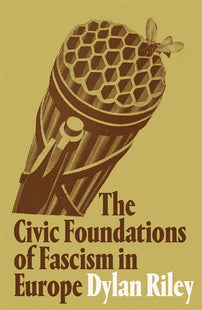What Is Trump?
Attempts to identify Trump with fascism have proliferated across the political spectrum. In the latest number of New Left Review, Dylan Riley argues that the comparison serves rather to illuminate the specificity of today’s political situation – and the incoherence of Trump’s form of rule.

Debates around the politics of Trump and other new-right leaders have led to an explosion of historical analogizing, with the experience of the 1930s looming large. According to much of this commentary, Trump—not to mention Orbán, Kaczynski, Modi, Duterte, Erdoğan—is an authoritarian figure justifiably compared to those of the fascist era. The proponents of this view span the political spectrum, from neoconservative right and liberal mainstream to anarchist insurrectionary. The typical rhetorical device they deploy is to advance and protect the identification of Trump with fascism by way of nominal disclaimers of it. Thus for Timothy Snyder, a Cold War liberal, ‘There are differences’—yet: ‘Trump has made his debt to fascism clear from the beginning. From his initial linkage of immigrants to sexual violence to his continued identification of journalists as “enemies” . . . he has given us every clue we need.’ For Snyder’s Yale colleague, Jason Stanley, ‘I’m not arguing that Trump is a fascist leader, in the sense that he’s ruling as a fascist’—but: ‘as far as his rhetorical strategy goes, it’s very fascist.’ For their fellow liberal Richard Evans, at Cambridge: ‘It’s not the same’—however: ‘Trump is a 21st-century would-be dictator who uses the unprecedented power of social media and the Internet to spread conspiracy theories’—‘worryingly reminiscent of the fascists of the 1920s and 1930s.’ [1]
From the right, former Republican adviser Max Boot insists: ‘To be clear, I am in no way suggesting there’s any analogy between Trump and Hitler’—however: ‘Trump is a fascist. And that’s not a term I use loosely or often.’ For the liberal neo-con Robert Kagan, ‘This is how fascism comes to America, not with jackboots and salutes’—but ‘with a television huckster, a phony billionaire, a textbook egomaniac “tapping into” popular resentments and insecurities.’ On the left, eco-Marxist John Bellamy Foster agrees that there are ‘historically distinct features’—yet Trump is nevertheless a systematic ‘neofascist’ who, like his interwar forebears, aims at ‘the repression of the workforce’. Queer theorist Judith Butler acknowledges, ‘With Trump, we have a different situation’—but ‘one which I would still call fascist.’ For social democrat Geoffrey Eley, ‘It makes no sense to draw direct equivalences’—nevertheless: ‘we have the kind of crisis that can enable a politics that looks like fascism to coalesce. And this is where Trump has prospered.’ For anarcho-syndicalist Mark Bray, ‘No, I wouldn’t say that Trump is a fascist’—although, ‘he has displayed quite a few fascistic qualities . . . Trump was enabled by fascism (among other things) and in turn enabled fascism.’ [2]
Another point these commentators have in common is that their analogies are rarely placed in a properly comparative and historical perspective. Instead they treat the past as a storehouse of disconnected examples to be pulled out for weaving morality tales or constructing yardsticks against which they measure the contemporary moment. The procedure is similar to what Hegel called the pragmatic form of reflective history, in which the writer searches for ‘examples of good deeds’ (or bad ones) without placing them in their historical context, thus creating a false immediacy in which the past appears as a reservoir of ‘lessons’. But as Hegel warned, ‘nothing is more shallow’. [3] Marx developed and sharpened Hegel’s critique in The Eighteenth Brumaire, suggesting that the pragmatic form could itself become a historical force, as when ‘Luther donned the mask of Apostle Paul, the Revolution of 1789 to 1814 draped itself alternately as the Roman republic and the Roman empire, and the Revolution of 1848 knew nothing better to do than to parody, now 1789, now the revolutionary tradition of 1793 to 1795.’ [4]
This approach to the past distorts the central question of contemporary politics. For the issue is not to explain why, in the aftermath of a severe financial and economic crisis in the capitalist core, accompanied by a massive upward transfer of wealth by ruling centrists, blue and red, right-wing—and, in a few instances, left-wing—outsiders have come to power, but rather why these politicians have largely remained within the established framework. In short, the question is not why our contemporary politics resembles those of the 1930s, but why it does not.
This is an extract from Dylan Riley's essay in New Left Review 114. To read the full essay, click here.
--------------------------
[1] Timothy Snyder, ‘Symposium: Repeating History’, TLS, 16 November 2018. Jason Stanley, interviewed by Isaac Chotiner, ‘OK, Trump’s Not a Fascist Leader—But does his fascist rhetoric mean he’s on the way to being one?’, Slate, 10 September 2018; see also Jason Stanley, How Fascism Works: The Politics of Us and Them, New York 2018, p. xiv. Richard Evans, ‘Symposium: Repeating History’.
[2] Chauncey Devega, ‘Max Boot on the End of Conservatism’, Salon, 16 October 2018. Robert Kagan, ‘This is how Fascism comes to America’, Washington Post, 18 May 2016. John Bellamy Foster, ‘Neo-Fascism in the White House’, Monthly Review, April 2017, and ‘This Is Not Populism’, Monthly Review, June 2017; see also Trump in the White House: Tragedy and Farce, New York 2017, p. 29. Judith Butler, ‘Trump, fascism and the construction of “the people”’, translation of Christian Salmon’s interview with Butler, ‘Pourquoi Trump est un Phénomène Fasciste’, Mediapart, 18 December 2016. Geoff Eley, ‘Is Trump a Fascist?’, Historians for Peace & Democracy, February 2018. Mark Bray, ‘Interview: “At Its Core, Anti-Fascism Is Self-Defence”’, Truthout, 11 February 2018. Of these, Bellamy Foster is distinctive in advancing the category of ‘neofascism’, a sub-family within the ‘fascist genus’ to which he claims Trump unqualifiedly belongs, and is thus not strictly representative of the apophatic ‘not actually fascist, but fascist nevertheless’ Trump discourse.
[3] G. W. F. Hegel, Reason in History: A General Introduction to the Philosophy of History, New Jersey 1997, p. 8.
[4] Karl Marx, The Eighteenth Brumaire of Louis Bonaparte, New York 1963, p. 15.
[book-strip index="1" style="buy"]
